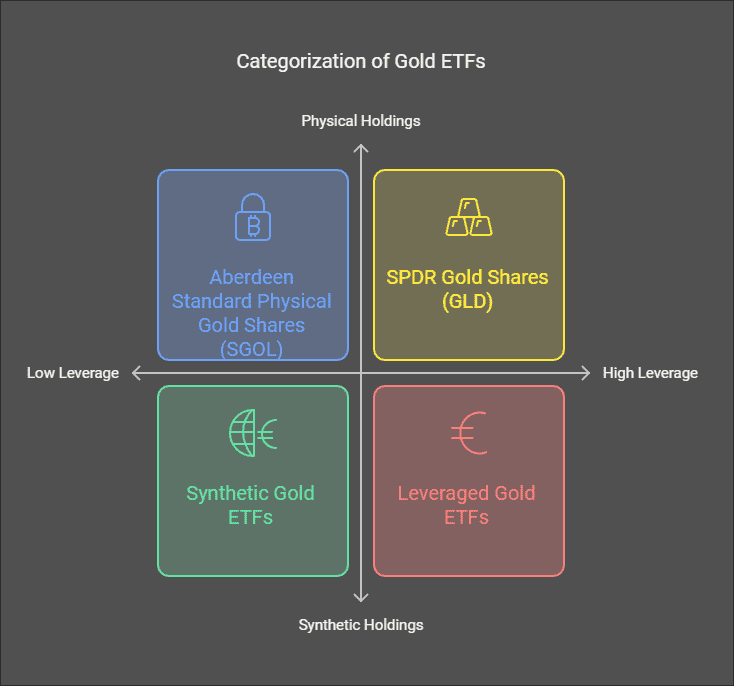Gold ETFs provide investors, including retail investors, an efficient way to gain exposure to the gold market without the complexities of owning physical bullion. These exchange-traded funds come in various forms, including Physical Gold ETFs, Synthetic Gold ETFs, and Leveraged Gold ETFs, each offering unique investment strategies.
Top choices in the market, like SPDR Gold Shares (GLD) and iShares Gold Trust (IAU), offer different approaches to gold investment, from holding physical gold to using derivatives for price tracking.
When selecting the best Gold ETF for your portfolio, consider your investment goals, expense ratios, and historical performance data. Understanding the risks, such as market volatility and liquidity, is also crucial.
Investors can purchase and manage these ETFs through brokerage accounts, financial advisors, or online trading platforms, making them accessible to a wide range of investment strategies and promoting portfolio diversification and asset management.
Key Takeaways:
- Consider your investment goals before choosing a gold ETF to ensure it aligns with your risk tolerance, financial goals, and objectives.
- Research the expense ratio and track record of a gold ETF before investing to make an informed decision.
- Purchase gold ETFs through a brokerage account, financial advisor, or online trading platform, and be aware of potential risks such as market volatility and liquidity risk.
What Are the Types of Gold ETFs and Their Risk Factors?
Types of Gold ETFs include:
- Physical Gold ETFs
- Synthetic Gold ETFs
- Leveraged Gold ETFs
Physical Gold ETFs invest directly in gold bullion. Synthetic Gold ETFs use derivatives to track gold prices. Leveraged Gold ETFs use financial leverage to increase returns.
1. Physical Gold ETFs
Physical Gold ETFs are investment funds that hold gold bullion in secure vaults, providing investors exposure to the gold market without owning physical gold.
Physical Gold ETFs allow investors to benefit from gold price movements and offer liquidity and an inflation hedge without storage concerns, serving as a safe haven during economic uncertainty.
2. Synthetic Gold ETFs and Their Role
Synthetic Gold ETFs are investment funds that use derivatives, such as futures and swaps, to replicate the performance of gold without owning physical gold.
Synthetic Gold ETFs provide exposure to gold price movements through derivative contracts, offering investors a way to track gold prices without physical storage.
3. Leveraged Gold ETFs
Leveraged Gold ETFs are investment funds that aim to deliver two or three times the performance of gold prices using financial leverage.
Leveraged Gold ETFs use derivatives to magnify gains and losses, making them suitable for investors seeking to profit from short-term gold price movements.
Leveraged Gold ETFs carry significant risks and require careful asset management.
Top Gold ETFs and Their Returns
Top gold ETFs include those providing exposure to gold prices and offering potential returns:
- SPDR Gold Shares (GLD)
- iShares Gold Trust (IAU)
- Aberdeen Standard Physical Gold Shares (SGOL)
- GraniteShares Gold Trust (BAR)
- VanEck Merk Gold Trust (OUNZ)
1. SPDR Gold Shares (GLD)
SPDR Gold Shares (GLD) is a gold ETF backed by physical gold stored in secure vaults.
GLD provides investors exposure to gold without needing to buy or store the physical asset.
Investing in GLD allows easy access to gold through brokerage accounts.
2. iShares Gold Trust (IAU)
iShares Gold Trust (IAU) is a gold ETF that provides exposure to physical gold with a low expense ratio.
IAU allows investors to invest in gold without buying or storing physical bullion.
iShares Gold Trust (IAU) is suitable for investors seeking a hedge against inflation, offering lower tracking error and a direct correlation to gold prices.
IAU is a liquid and accessible investment, ideal for both novice and experienced investors.
3. Aberdeen Standard Physical Gold Shares (SGOL)
Aberdeen Standard Physical Gold Shares (SGOL) is an ETF that provides investors with direct ownership of physical gold, stored in Swiss vaults.
SGOL works by allowing investors to own actual gold bullion, offering a hedge against economic uncertainty and inflation.
SGOL combines the stability of physical gold with the liquidity of a traded fund.
4. GraniteShares Gold Trust (BAR)
GraniteShares Gold Trust (BAR) is a gold ETF designed to provide cost-effective exposure to gold by holding physical gold bullion.
BAR tracks gold prices directly without using futures contracts, offering investors a hedge against inflation and market volatility.
5. VanEck Merk Gold Trust (OUNZ)
VanEck Merk Gold Trust (OUNZ) is a gold ETF allowing investors to exchange shares for physical gold.
Unlike traditional gold ETFs, OUNZ offers direct conversion of shares into physical gold.
This feature provides flexibility in gold investment and caters to investors seeking tangible assets.
OUNZ is suitable for diversifying portfolios by linking financial interests with physical gold.
How to Choose the Best Gold ETF for Your Portfolio: A Guide for Retail Investors
To choose the best gold ETF for your portfolio, analyze your investment goals, compare expense ratios, and evaluate the fund’s historical performance.
Consider the ETF’s method of holding gold (physical or synthetic), assess liquidity, review fund size, and compare it to relevant benchmarks.
This evaluation helps investors select a gold ETF that aligns with financial objectives and enhances portfolio diversification.
1. Consider Your Investment Goals
When selecting a gold ETF, consider your investment goals such as capital appreciation, inflation hedge, or portfolio diversification.
Capital appreciation may favor ETFs tracking gold mining stocks, while an inflation hedge might prefer ETFs holding physical gold.
For diversification, a mix of gold ETFs balancing physical gold and mining stocks could be optimal.
2. Look at the Expense Ratio
The expense ratio in gold ETFs represents the annual cost of managing the fund, expressed as a percentage of total assets.
A lower expense ratio allows more investment to remain in the market, reducing costs and potentially increasing returns.
Investors should compare expense ratios in gold ETFs to minimize fees and enhance net returns.
3. Research the Track Record
Researching the track record of gold ETFs involves examining past performance data to assess reliability.
Gold ETFs’ track record evaluation includes analyzing historical returns, performance consistency during market fluctuations, and volatility levels.
Research specific trends and metrics to understand potential risks and align investment strategies with financial goals.
4. Consider the Method of Holding Gold
Holding gold can be done through physical gold ETFs or synthetic gold ETFs, affecting risk and investment outcomes.
Physical gold ETFs give investors direct exposure to gold as tangible assets, which involves higher storage and insurance costs.
Synthetic gold ETFs use derivatives to track gold prices, offering lower fees and higher liquidity but introducing counterparty risks.
Understanding these methods is crucial for informed gold investment decisions.
What Are the Risks of Investing in Gold ETFs: Key Risk Factors
Risks of investing in gold ETFs include market volatility, currency risk, counterparty risk, and liquidity risk.
Market volatility affects gold prices, impacting ETF value. Currency risk impacts returns for investors not using USD. Counterparty risk arises from reliance on financial institutions. Understanding these risk factors is essential for informed investment decisions.
Liquidity risk affects the ability to buy or sell ETFs easily.
1. Market Volatility
Market volatility refers to the rapid and unpredictable changes in gold prices that affect gold ETFs, posing risks of unexpected gains or losses for investors.
Volatility is influenced by economic indicators, such as interest rate changes and geopolitical tensions, which can drive gold prices up or down.
2. Currency Risk
Currency risk arises from fluctuations in exchange rates that can impact investment returns.
When investing in gold ETFs priced in U.S. dollars, international investors face currency risk if their local currency depreciates against the dollar, reducing returns.
If the local currency strengthens, returns might increase.
Understanding currency risk helps in assessing gold ETF value and making informed asset allocation decisions.
3. Counterparty Risk
Counterparty risk refers to the risk that the entity managing a gold ETF may not fulfill its obligations, impacting investors’ security.
Gold ETF investors face counterparty risk as they rely on the custodian to protect assets and ensure accurate reporting.
Mitigating counterparty risk involves evaluating the ETF provider’s credit ratings, assets under management, and regulatory compliance, and diversifying investments.
4. Liquidity Risk
Liquidity risk in gold ETFs refers to the difficulty in buying or selling shares without affecting the price, especially during market volatility.
Liquidity risk can result in wider bid-ask spreads and delayed order execution.
Investors can manage liquidity risk by diversifying ETF portfolios, using limit orders, and trading during peak hours.
How to Buy and Sell Gold ETFs?
To buy and sell Gold ETFs, use a brokerage account to access the stock market, which includes gold mining companies and other investment options.
Buy Gold ETFs by searching for the ETF ticker symbol and placing a purchase order through your brokerage platform.
Sell Gold ETFs by navigating to your holdings, selecting the ETF, and executing a sell order. Consider the performance data and gold price before making a decision.
Gold ETFs are bought and sold during market hours just like regular stocks, providing retail investors with opportunities for returns.
1. Through a Brokerage Account
Investors can buy gold ETFs through a brokerage account by trading them on stock exchanges, which can be impacted by stock market and market volatility.
Using an online brokerage allows access to various gold ETFs, providing exposure to gold without physical storage. This method is popular among retail investors who seek ease of access and flexibility.
Investors should consider account types, such as individual or retirement accounts, and compare associated fees, including trading commissions, management fees, and expense ratios for efficient asset management.
Brokerages like Fidelity and Charles Schwab offer platforms to manage gold ETF investments efficiently, helping investors meet their financial goals and manage risk factors.
2. Through a Financial Advisor
Investors can buy gold ETFs through a financial advisor who provides guidance on selecting ETFs that fit an investment portfolio, considering diversification and risk factors.
A financial advisor evaluates market trends, fees, and risk tolerance, and may consider gold mining companies to align gold ETF purchases with financial goals.
Using a financial advisor helps investors integrate gold ETFs for diversification and manage investment risk, including acting as an inflation hedge.
3. Through an Online Trading Platform
An online trading platform allows investors to buy gold ETFs from anywhere, offering ease of access and flexibility, and can also provide performance data and analysis tools.
These platforms provide cost efficiencies by reducing commissions and transaction fees compared to traditional brokerages, making them attractive to Gen Xers and other tech-savvy investors.
Online trading platforms offer tools for research and analysis, including market data, price charts, and analyses, useful during market volatility.
Investors can manage and monitor their gold ETF investments conveniently through these platforms, ensuring their portfolio aligns with their investment strategy.
Frequently Asked Questions About Gold ETFs
What are the best Gold ETFs for investing? Consider ETFs that offer a good balance of expense ratio and performance data.
There are several top-performing Gold ETFs, including SPDR Gold Shares (GLD), iShares Gold Trust (IAU), and Aberdeen Standard Physical Gold Shares (SGOL). These ETFs provide investors with exposure to physical gold and act as a safe haven without the challenges of owning and storing the physical metal.
How do I choose the best Gold ETF for my portfolio? Look at factors like expense ratio, performance data, and asset management quality.
When selecting a Gold ETF, consider factors such as expense ratio, liquidity, and holdings. Additionally, research the performance and track record of the ETF to ensure it aligns with your investment goals, risk tolerance, and potential returns, especially in connection with gold mining activities.
Can I buy Gold ETFs through my regular stock broker? Evaluate the brokerage’s expense ratios and other fees.
Yes, Gold ETFs can be bought and sold through any brokerage account, just like stocks. However, some brokers may charge additional fees for trading ETFs, so it’s important to research and compare fees before making a purchase.
Are Gold ETFs a good investment for diversification? They can also act as a hedge against economic downturns and inflation.
Gold ETFs can be an excellent addition to a diversified portfolio as they can help reduce risk and provide a hedge against inflation and economic uncertainty. They offer the benefit of an inflation hedge and can act as a safe haven during economic downturns. However, it’s important to carefully consider your overall investment strategy and consult with a financial advisor when making any investment decisions.
What are the tax implications of investing in Gold ETFs? Consult a tax advisor for advice on collectibles taxation.
Gold ETFs are taxed as collectibles, which means they are subject to a maximum long-term capital gains tax rate of 28%. Short-term capital gains are taxed at the investor’s ordinary income tax rate. It’s best to consult with a tax professional for specific tax advice related to your investment in Gold ETFs, particularly considering the tax implications of trading them in various account types.
Can I trade Gold ETFs on margin? Understand the market volatility and risks before doing so.
Some brokers may offer margin trading for Gold ETFs, but it’s important to understand the risks associated with trading on margin. Margin trading allows investors to borrow money to purchase more shares, but it also amplifies potential losses. Always consult with your broker and assess your risk tolerance before trading on margin, and consider the market volatility and potential margin calls.
Authors & Disclosures
- Our content is independently written and reviewed by trusted reviewers & fact-checkers.
- We can earn money by connecting you with top Gold IRA Companies. Learn how our reviews work.
- Want to learn more? Meet our authors and explore our editorial policy.
















